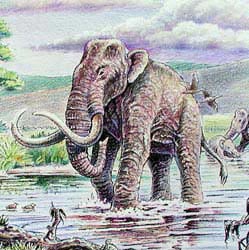Calico Early Man Site, Mannix Basin, Yermo, California / o)mammothscrapers
"Two Calico Convex Scrapers. (Coated with powdered aluminum.) (Left) Jasper flake with bifacial face flaking including long ribbon flake scars on both sides. A multi-purpose tool with retouched and denticulate margins that show use-wear. From a depth of 3.38 m in Master Pit I" [Fred E. Budinger Jr., Calico Project Director, Calico Early Man Site, www.calicodig.org].
Palaeoart Interpretation (James Harrod): (Left) Tentatively, based on the photo, I suggest the scraper on the left has a 'blade-like' removal intended to create a resemblance of the entire piece to a 'mammoth', the 'blade' removal representing the 'trunk'. Toward the top of the removal there appear to be two retouch flake removals on the 'blade' edge, which might be intentional to indicate the mammoth's two 'eyes'. (Right) This scraper has a similar shape and is also vaguely suggestive of a mammoth, with slightly S-curved trunk and a flake removal at top of this edge to represent the mammoth's forehead.
(Left) The double pointed bumps at top of the 'head' may be intended to represent the specific species, Mammuthus columbi or imperator, which has such a double lobed head, as opposed to the more rounded head of Mammut americanum (mastodon). (Right) The diagonal flake removal at the 'head' of this piece may also represent columbi/imperator. The largest species of mammoth (Mammuthus imperator) reached 13 feet (3.9 meters); compared to mastodons, mammoths had wider heads, a more sloping back, and longer, curved tusks. See illustration of Mammuth imperator below [Google image, San Diego Natural History Museum, http://www.sdnhm.org/exhibits/mystery/fg_mammoth.html].
Photo © D. Griffin [Calico Early Man Site, www.calicodig.org].
|




mammothscrapers22.jpg)
